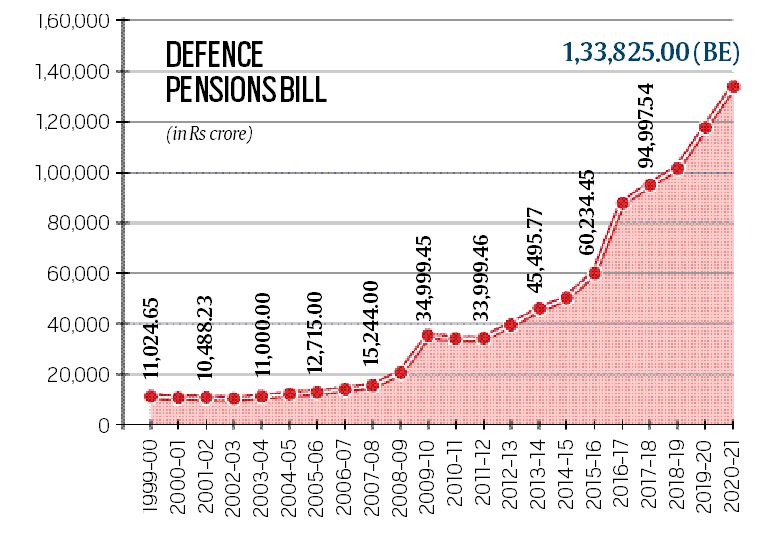Note4Students
From UPSC perspective, the following things are important :
Prelims level: Not Much
Mains level: Issue of ever-increasing defence expenditure

The Union Budget for 2020-21 has allocated Rs 1,33,825 crore to defence pensions. This is up by 10½ times in a decade and a half, from Rs 12,715 crore in 2005-06.
The ‘hype’ of defence pension
- The allocation of Rs 1,33, 826 crore is 4.4% of the total expenditure of the central government or 0.6% of GDP.
- And of the overall allocation made to the Defence Ministry, 28.4% goes towards pensions.
- So sharply has the bill for defence pensions gone up that it is now Rs 15,291 crore more than the Defence Ministry’s total capital expenditure, a bulk of which goes towards modernization of the armed forces.
- It now nearly equals the salaries bill for Defence Ministry. The more the government spends on salaries and pensions, the less it can spend on modernizing the armed forces.
- To put it in perspective, the government’s spending on education is Rs 99,300 crore and on health is Rs 69,000 crore.
- To compare it with other sectors, the government’s rural employment scheme MGNREGA has an allocation of only Rs 61,500 crore — 46% of the bill for defence pensions.
Why the bill is high?
- As per the Defence Ministry, there are about 26 lakh armed forces pensioners and family pensioners and approximately 55,000 pensioners are added every year.
- In 2015, the government announced the OROP (One Rank, One Pension) scheme which cost it Rs 8,600 crore.
- The implementation of the Seventh Pay Commission recommendations in 2017 again increased the defence pensions bill.
What makes defense pensions distinct?
- Defence pensions are unique in many ways. Defence personnel retire at a young age and thus continue to get pensions for a longer period of time than their civilian counterparts.
- The current ratio of military pensioners to serving military personnel is 1.7 to 1, while the ratio of civil pensioners to civil working personnel is 0.56 to 1.
- This ratio in defence is projected to further change as life expectancy in India goes up and retired personnel live far longer than earlier.
- All civilian employees in the government who joined service on or after 1 January 2004 do not get an assured pension but come under the ambit of the contributory National Pension Scheme (NPS).
- That is meant to reduce the pensions bill of the government on the civilian side, but military personnel have been excluded from the ambit of the NPS because of their short service span.
Where this can lead to
- With economic growth stalling and competing requirement from development and infrastructure sectors, the government is being hard-pressed for the last rupee in its kitty.
- The defence services themselves need more funds to modernize themselves but are struggling with budgetary allocations.
- In such a scenario, attention is likely to come to the fast-rising defence pensions bill.
Feasible solutions
- The short-term answer to keep the bill frozen at the same level is to increase the retirement age of serving military personnel and stop the rise in number of pensioners.
- But at a time when the country is facing unemployment at an all-time high, stopping recruitment for a few years will worsen the situation.
- The other solution is to send the retired military personnel to paramilitary forces but those forces, too, need to stay young and have not accepted the proposal.
- That would also pose the problem of recruitment in a time of high unemployment, as in the case of increase in retirement age of military personnel.
Conclusion
- The sharply rising defence pensions bill, however, has become a challenge that cannot be ignored any longer.
- Unless India’s economy grows at a double-digit rate, it will not be possible to furnish this bill and still modernize the armed forces.
- There are no easy answers to the challenge, and the answer will have to come from the top political leadership.
Get an IAS/IPS ranker as your 1: 1 personal mentor for UPSC 2024
